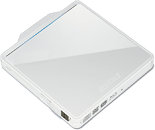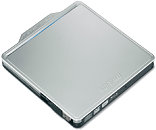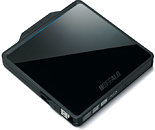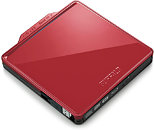Wednesday, August 28th 2013

Buffalo Rolls Out External Blu-ray XL Writers with Optional Power Input
Typical officegoers often don't understand the underlying power distribution with desktop USB hubs, which plug into the computer's rear USB ports, and give out four downstream ports on the desk. When a power-hungry USB device like external HDD or external optical drive is plugged into such downstream ports, it falls short of power, and doesn't work reliably. To address just that, Buffalo rolled out a new line of portable Blu-ray XL writer drives, which give you the flexibility of both bus-only power, and DC power input (referred to by Buffalo as "power boost").
The new BRXL-PC6VU2-C line of portable Blu-ray writers, pictured below, are capable of running bus-powered. If the drive detects it isn't getting enough power from its USB port, it lights up an LED, which prompts you to plug in its AC adapter, which makes up for the power deficit. When bus powered, the drive is limited to low read/write speeds, to keep power draw from the motor low (reliable, prevents write errors). This neat little arrangement makes sure the drive runs smoothly when it's plugged in directly to a computer, and gives you the flexibility of plugging it into a hub. Measuring 145 x 153 x 19 mm (WxDxH), the drive weighs about 340 g. Blu-ray XL 4-layer and 3-layer discs are written at 4X, single- and double-layer Blu-ray at 6X. When bus-powered, it writes all kinds of Blu-ray RE drives at 2X. When "power-boosted," those speeds go up to 6X. DVDs are written at speeds of up to 8X, CDs at 24X. Slated for an early-September launch in Japan, these drives are expected to go for 10,920 JPY (US $112).
Source:
Hermitage Akihabara
The new BRXL-PC6VU2-C line of portable Blu-ray writers, pictured below, are capable of running bus-powered. If the drive detects it isn't getting enough power from its USB port, it lights up an LED, which prompts you to plug in its AC adapter, which makes up for the power deficit. When bus powered, the drive is limited to low read/write speeds, to keep power draw from the motor low (reliable, prevents write errors). This neat little arrangement makes sure the drive runs smoothly when it's plugged in directly to a computer, and gives you the flexibility of plugging it into a hub. Measuring 145 x 153 x 19 mm (WxDxH), the drive weighs about 340 g. Blu-ray XL 4-layer and 3-layer discs are written at 4X, single- and double-layer Blu-ray at 6X. When bus-powered, it writes all kinds of Blu-ray RE drives at 2X. When "power-boosted," those speeds go up to 6X. DVDs are written at speeds of up to 8X, CDs at 24X. Slated for an early-September launch in Japan, these drives are expected to go for 10,920 JPY (US $112).




2 Comments on Buffalo Rolls Out External Blu-ray XL Writers with Optional Power Input
To make optical disc writers relevant again, we'd need a disc with a capacity of 1 terabyte or more and a cost of under $5 per blank. That would be great for backups. But 128GB on insanely overpriced discs (over $75 apiece!) is just not viable.